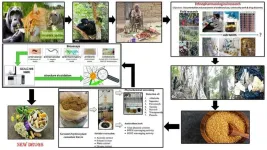(Press-News.org)
Graphics // Photos
The earliest humans to settle the Great Lakes region likely returned to a campsite in southwest Michigan for several years in a row, according to a University of Michigan study.
Until recently, there was no evidence that people from the Clovis period had settled the Great Lakes region. Clovis people appeared in North America about 13,000 years ago, during the geologic epoch called the Pleistocene. During the Pleistocene, sheets of glaciers covered much of the world, including Michigan, making the land inhospitable for human settlers. But a 2021 U-M study confirmed that Clovis people built a camp, now called the Belson site, in southwest Michigan.
Now, the same researchers have confirmed that Clovis people traveled to the site annually, probably in the summer, for at least three but likely up to five consecutive years, according to Brendan Nash, lead author of the study and a doctoral student of archaeology. Tools from the site also show evidence that the settlers' diets included a wide variety of animals, ranging from rabbits to musk ox. The team's results are published in the journal PLOS ONE.
At the Belson site, the researchers discovered tools that were made with a type of stone called chert from what is now western Kentucky, about 400 miles from the Belson site. These tools were then resharpened at the Belson site, leaving behind small pieces for researchers to analyze.
Thomas Talbot, an independent researcher who discovered the first Clovis point at the Belson site in Mendon, Michigan, in 2008, also conducts the group's chert analysis. He discovered some of these chert pieces were from Paoli chert, which formed in northeastern Kentucky.
"It took me a year to identify it, and when I did, it was very surprising," Talbot said. "Then we found a broken base, which we call a diagnostic. The broken base was made from that Paoli material. Once you read the paper and look at the data and maps, there are some patterns that are starting to emerge that are pretty cool."
The tools made in what is now Kentucky were traded to people in central Indiana, who then carried them to the Belson site. Nash says this suggests that the people who settled the Belson site likely moved there during summers and lived in central Indiana during the winter. They in turn likely traded for the tools from western Kentucky from people who moved from central Indiana to Kentucky on yearly routes.
"In this way, people formed 'links in a chain' with yearly routes that likely connected the whole continent, from Michigan to Mexico," Nash said. "This is likely why technology from the Clovis period is so similar throughout most of North America."
The Clovis period is characterized by distinctive spear points. The points have a very characteristic central channel through the length of the tool, called a flute. A Clovis person would have used this channel as a place to attach a shaft to the spearhead, creating a composite hunting weapon—a spear that was used to hunt prey of all sizes. Also distinctive to the Clovis people is that they struck large flakes of material off the stone to create their points. The large, detached pieces had razor-sharp edges and would be used as expedient knives themselves.
It is currently unclear where in the Americas Clovis technology was invented, but once it was, it spread quickly, according to archaeological standards. Researchers think they are one of the earliest groups of people to settle the Americas, and prior to the 2021 study, Clovis technology had not been reported from the Great Lakes region.
Talbot found the first Clovis point in the Belson farm field in 2008. He recognized it as a Clovis point both from its distinctive shape and that it was made of Attica chert, a kind of stone found 120 miles from the Belson site, in western Indiana and eastern Illinois. Talbot confirmed his findings with U-M archaeologist Henry Wright.
Wright and Talbot visited the site in 2017, finding finished tools and small flakes of Attica chert, which made them suspect people had lived at the site rather than simply dropping a point or tool cache as they were passing through. Talbot, Wright and Nash's 2021 study described the surface sampling of the site.
The current study examines excavations of buried flakes—chips off of stone created when the Clovis people were resharpening, or creating, their points—and multiple tools buried in less disturbed sediment beneath the plowed surface layers of the field.
The researchers examined three of the dozens of discovered stone tools for traces of protein. They found evidence for musk ox, caribou or deer, hare and peccary, a Pleistocene relative of the pig. The hare and peccary protein came from the same Clovis point, according to Nash.
"Taken together, the ancient protein data suggests that these people had a broad spectrum diet, eating a wide variety of animals," Nash said. "Our findings are contrary to the popular notion that Clovis people were strictly big game hunters, most often subsisting on mammoths and mastodons."
Nash says the Clovis people would have also eaten plants, but plant material does not show up on protein tests, and unlike animal bones, their remains don't typically last for 13,000 years.
"This site teaches us about a way of life lost to time," Nash said. "Through the sourcing of stone and the styles of tools, we are tracking a group of people as they live and travel across the Pleistocene landscape of the American Midwest."
In addition to Wright and Talbot, study co-authors include former U-M graduate student Elliot Greiner and Linda Scott Cummings of the PaleoResearch Institute in Colorado.
Study: Clovis organizational dynamics at a late glacial campsite in the central Great Lakes: Belson site excavations 2021 (DOI: 10.1371/journal.pone.0302255)
END
Clovis people used Great Lakes camp annually 13,000 years ago
2024-09-11
ELSE PRESS RELEASES FROM THIS DATE:
Can having a stroke change your sleep?
2024-09-11
EMBARGOED FOR RELEASE UNTIL 4 P.M. ET, WEDNESDAY, SEPTEMBER 11, 2024
MINNEAPOLIS – People who have had a stroke may be more likely to sleep too much or too little compared to those without prior stroke, according to a study published in the September 11, 2024, online issue of Neurology®, the medical journal of the American Academy of Neurology. The study does not prove that stroke causes abnormal sleep; it only shows an association.
“Sleeping the right amount is considered essential for ideal brain and heart health,” said study author Sara Hassani, ...
Microscale robot folds into 3D shapes and crawls
2024-09-11
ITHACA, N.Y. – Cornell University researchers have created microscale robots less than 1 millimeter in size that are printed as a 2D hexagonal “metasheet” but, with a jolt of electricity, morph into preprogrammed 3D shapes and crawl.
The robot’s versatility is due to a novel design based on kirigami, a cousin of origami, in which slices in the material enable it to fold, expand and locomote.
The team’s paper, “Electronically Configurable Microscopic Metasheet Robots,” published Sept. 11 in Nature Materials. The paper’s co-lead authors are postdoctoral ...
New noninvasive technique provides effective treatment for urinary stones
2024-09-11
September 11, 2024 — A noninvasive ultrasound technology called Break Wave™ lithotripsy (BWL) offers a safe and effective new option for treatment of urinary stones, reports a clinical trial in the October issue of The Journal of Urology®, an Official Journal of the American Urological Association (AUA). The journal is published in the Lippincott portfolio by Wolters Kluwer.
"In this initial experience, BWL provided a high treatment success rate, using a portable technology that can be used in a range of settings, without the need for anesthesia" comments lead ...
Researchers uncover new infection-fighting molecules through “molecular de-extinction”
2024-09-11
A new study led by Cesar de la Fuente, PhD, Presidential Assistant Professor of Psychiatry, Microbiology, Chemistry, Chemical and Biomolecular Engineering, and Bioengineering at the University of Pennsylvania, has uncovered sequences for infection-fighting molecules in the genomic data of extinct species. This most recent study in the emerging field of “molecular de-extinction”, pioneered by Prof. de la Fuente, offers the potential to develop new antimicrobial treatments in the fight against rising antibiotic resistance.
The study, published in Cell Reports Physical Science, analyzed genomic data from the extinct moa, a flightless bird from New Zealand, ...
Keeping mold out of future space stations
2024-09-11
COLUMBUS, Ohio – Mold can survive the harshest of environments, so to stop harmful spores from growing on future space stations, a new study suggests a novel way to prevent its spread.
Researchers created a predictive approach for modeling unintended microbial growth in critical spaces and applied it to life on the International Space Station.
An analysis of dust samples obtained from the space station found that repeated elevated humidity exposures for even a short time can lead to rapid microbial growth and composition changes in dust that make it easier for microbes, ...
"It feels like I'm moving my own hand". A research team from the Scuola Superiore Sant'Anna in Pisa has developed the prosthesis of the future, the first in the world with magnetic control
2024-09-11
Pisa, 11 september. It is the first magnetically controlled prosthetic hand, that allows amputees to reproduce all movements simply by thinking and to control the force applied when grasping fragile objects. No wires, no electrical connection, only magnets and muscles to control the movements of the fingers and enable everyday activities such as opening a jar, using a screwdriver, picking up a coin.
A research team from the BioRobotics Institute of the Scuola Superiore Sant'Anna in Pisa, coordinated by Prof. Christian Cipriani, has ...
Self-medicating gorillas and traditional healers provide clues for new drug discovery
2024-09-11
Four plants consumed by wild gorillas in Gabon and used by local communities in traditional medicine show antibacterial and antioxidant properties, find Leresche Even Doneilly Oyaba Yinda from the Interdisciplinary Medical Research Center of Franceville in Gabon and colleagues in a new study publishing September 11 in the open-access journal PLOS ONE.
Wild great apes often consume medicinal plants that can treat their ailments. The same plants are often used by local people in traditional medicine.
To investigate, researchers observed the behavior of western lowland gorillas (Gorilla gorilla ...
Trust in police declined among Black Chicago residents after Jacob Blake shooting
2024-09-11
Survey data collected from Chicago, Illinois at the time of the 2020 police shooting of Jacob Blake in nearby Wisconsin shows that trust in police plummeted among Black residents after the shooting. Jonathan Ben-Menachem and Gerard Torrats-Espinosa of Columbia University in New York, U.S., present these findings in the open-access journal PLOS ONE on September 11, 2024.
For young minority men in the U.S., police violence has become a leading cause of death. Prior research has explored how police violence and misconduct might reduce trust in police, but most studies have been limited in ...
Quitting smoking reduces risk of atrial fibrillation
2024-09-11
Quitting cigarettes can significantly lower a person’s risk of atrial fibrillation (AFib) compared to those who continue to smoke, according to a study published today in JACC: Clinical Electrophysiology. The findings show that the benefits of quitting start right away, suggesting that it is possible to reverse the risk of negative health outcomes.
“The findings provide a compelling new reason to show current smokers that it’s not too late to quit and that having smoked in the past doesn’t ...
How many people have A-Fib? Three times more than we thought
2024-09-11
Atrial fibrillation, a rapid, irregular heart beat that can lead to stroke or sudden death, is three times more common than previously thought, affecting nearly 5% of the population, or 10.5 million U.S. adults, according to new estimates from UC San Francisco.
A-Fib, as the condition is commonly known, has been on the rise for at least the past decade, driven by the aging of the population, along with increasing rates of hypertension, diabetes and obesity. Earlier projections had estimated that 3.3 million U.S. adults ...


